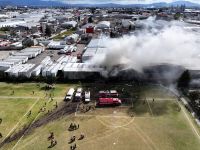ALBAWABA – A new study published on Nature based on data from aircraft revealed that researchers discovered that Methane emissions from many of the targeted regions, like US gas wells and pipelines, were far greater than what the government had estimated.
Methane emissions, which almost a third of the planet's overall global warming so far has been caused by, are revealed by the study to be three folds what the US government had anticipated to be and resulting in annual environmental harm of almost $9.3 billion.
The robust heat-trapping Methane gas According to the EPA, only remains in the atmosphere for around ten years as opposed to hundreds of years like carbon dioxide, but during a two-decade period, it traps nearly 80 times more heat.
On the bright side, according to lead author in the study Evan Sherwin, more than 50 percent of these emissions are resulting for a mere number of 1 percent of gas and oil locations, meaning that the while the problem is much worse than expected, it is considered “fairly fixable.”
Evan Sherwin, who authored the study while attending Stanford University and works as an energy and policy analyst for US Department of Energy’s Lawrence Berkeley National Lab, noted that “If we can get this roughly 1% of sites under control, then we’re halfway there because that’s about half of the emissions in most cases,” adding “It’s actually straightforward to fix.”
The research discovered that, in contrast to 1 percent expected according to the Environmental Protection Agency, over 3 percent of the gas generated in the US ends up being wasted and vented into the atmosphere. According to Sherwin, there was a significant 6.2 million tons per hour of leakage recorded over the day, but no numbers were measured at night, so it might be lower.









